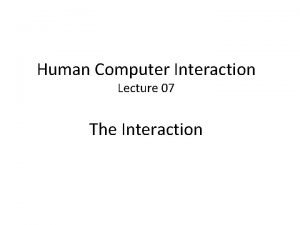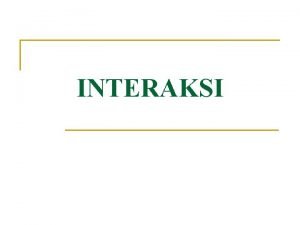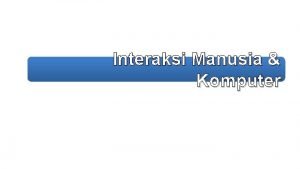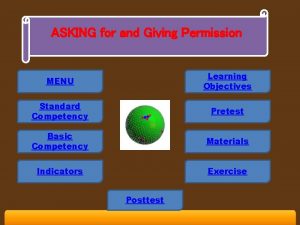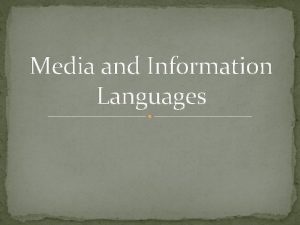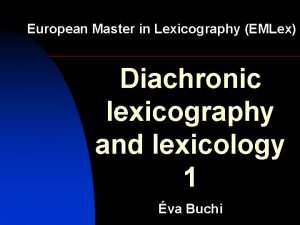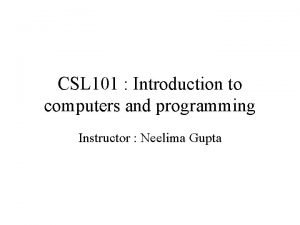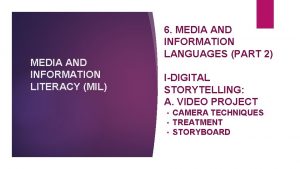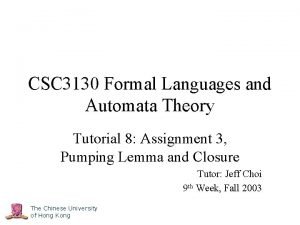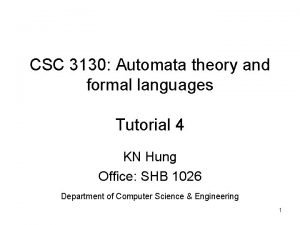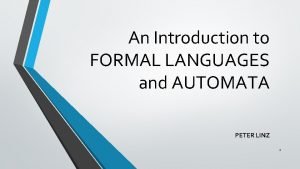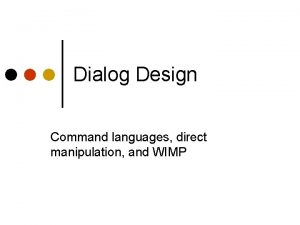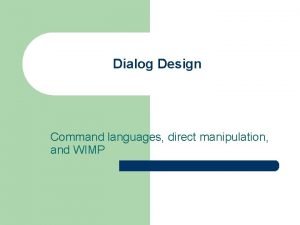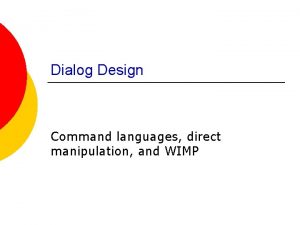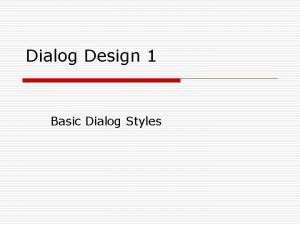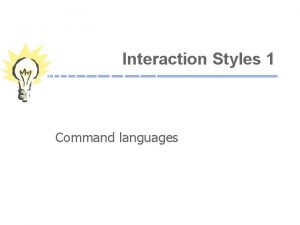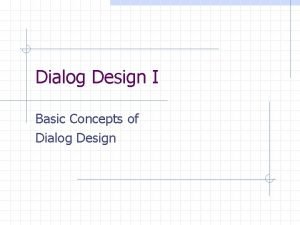Dialog Design 1 Command languages and WIMP Command


























- Slides: 26

Dialog Design 1 Command languages and WIMP • Command languages - Advantages, disadvantages - Design guidelines • WIMP - Advantages, disadvantages - Design guidelines Fall 2002 CS/PSY 6750 1

Dialog Design • How does a user interact with the interface? Fall 2002 CS/PSY 6750 2

Dialog Styles • • • 1. 2. 3. 4. 5. Fall 2002 Command languages WIMP - Window, Icon, Menu, Pointer Direct manipulation Speech/Natural language Gesture, pen, VR CS/PSY 6750 3

Command Languages • Earliest UI interaction paradigms • Examples - MS-DOS shell - UNIX shell - d. Base - GPSS Fall 2002 CS/PSY 6750 4

CL Attributes • Work primarily by recall, not recognition • Heavy memory load • Little or nothing is visible so… • Poor choice for novices but. . . Fall 2002 CS/PSY 6750 5

CL Advantages • Advantages for experts - Speed, conciseness %ls (hard to beat) - Can express actions beyond a limited set Flags, piping one command to another - Repetition, extensibility Scripting, macros - Easier implementation, less overhead - Power Abstraction, wild cards Fall 2002 CS/PSY 6750 6

CL Dangers • With added power, comes added responsibility and danger - UNIX % rm -r * Deletes every file that you have, and you can’t get them back Fall 2002 CS/PSY 6750 7

CL Reflection • Command languages are often maligned (for good reason) • But increased functionality can win out over bad UI (e. g. , UNIX) - Try to get both - Avoid excess functionality (comes at cost) Fall 2002 CS/PSY 6750 8

CL Design Goals • Consistency • Good naming and abbreviations • Doing your homework in design can help alleviate some of the negatives Fall 2002 CS/PSY 6750 9

Consistency • Provide a consistent syntax - In general: Have options and arguments expressed the same way everywhere - UNIX fails here because commands were developed by lots of different people at different organizations No guidelines provided Fall 2002 CS/PSY 6750 10

Order • English: SVO subject verb object “you” assumed on computer • CL: S assumed (you) - Is VO or OV better? % delete file or % file delete • V d. O i. O vs. V i. O d. O - % print file calvin - % lpr -Pcalvin file Fall 2002 Which is better? CS/PSY 6750 11

Syntax • Pick a consistent syntax strategy - Simple command list e. g, vi, minimize keystrokes - Commands plus arguments realistic, can provide keyword parameters % cp from=foo to=bar - Commands plus options plus arguments what you usually see Fall 2002 CS/PSY 6750 12

Terminology • Keep terminology consistent - Same concept expressed with same options - Useful to provide symmetric (congruent) pairings forward/backward next/prev control/meta Fall 2002 CS/PSY 6750 13

Example • vi text editor - w - forward word - backward word • Wouldn’t ‘f’ be better forward? - ‘f’ already used • How about ‘fw’ and ‘bw’? - Extra keystrokes Fall 2002 CS/PSY 6750 14

Ordering • Keep ordering consistent - VO seems to be the most natural - Typically need to pick where options go • Example - % ln -s file 1 file 2 (I can never remember) - Think of % cp file 1 file 2 Fall 2002 CS/PSY 6750 15

Names and Abbreviations • Specificity versus Generality - General words More familiar, easier to accept - Specific (typically better) More descriptive, meaningful, distinctive - (Nonsense does surprisingly well in small set) Fall 2002 CS/PSY 6750 16

Abbreviations • Abbrevs. allow for faster actions - Expert performance begins to be dominated by motor times such as # of keystrokes - Not good idea for novices - (Allow but don’t require) Fall 2002 CS/PSY 6750 17

Picking Good Abbreviations • Strategies - Simple truncation (works best, but conflicts) - Vowel drop plus truncation (avoid conflicts) - First and last letters - First letters of words in a phrase - Standard abbrev from other contexts qty, rm, bldg - Phonics xqt Fall 2002 CS/PSY 6750 18

Abbreviation Guidelines • Use single primary rule (with single fallback for conflicts) • Use fallback as little as possible • Mark use of fallback in documentation • Let user know primary and secondary rules • Truncation is good but generates conflicts • Fixed length is better than variable length • Don’t use abbrevs. in system output Fall 2002 CS/PSY 6750 19

Abbreviations Matter. . . Fall 2002 CS/PSY 6750 20

WIMP • Focus: Menus, Buttons, Forms • Predominant interface paradigm now (with some direct manipulation added) • Advantages: -? Fall 2002 CS/PSY 6750 21

Menus • Key advantages: - 1 keystroke or mouse operation vs. many - No memorization of commands - Limited input set • Many different types Fall 2002 pop-up pull-down radio buttons pie buttons hierarchies CS/PSY 6750 22

Menu Items • Organization strategies - Create groups of logically similar items - Cover all possibilities - Ensure that items are non-overlapping - Keep wording concise, understandable Fall 2002 CS/PSY 6750 23

Bad Example • Travel web page links: - Flight page - 3 Best Itineraries - Flights & Prices - Timetables - Fares • Which do you choose for reservations? Fall 2002 CS/PSY 6750 24

Presentation Sequence • How does Mac, Netscape, etc, do it? • Use natural if available - Time e. g. Breakfast, Lunch, Dinner - Numeric ordering e. g. Point sizes for font • Choices - Fall 2002 Alphabetical Group related items Frequently used first Most important first CS/PSY 6750 25

Presentation Sequence • User studies - Novices: alpha > functional > random - Experts: categorization • How would you do it in general? • One possible methodology (first->last) - Natural order (if exists) Frequency of use Order of use Categorical Alphabetical • Don’t change dynamically! Fall 2002 CS/PSY 6750 26
 Elements of the wimp interface
Elements of the wimp interface Ragam dialog (dialog style)
Ragam dialog (dialog style) Jendela tty
Jendela tty Perintah yang harus ditik merupakan model interaksi
Perintah yang harus ditik merupakan model interaksi Wimp adalah
Wimp adalah Paradigma imk
Paradigma imk Expression of leaving taking
Expression of leaving taking Ciri khas interface question and answer dialog adalah
Ciri khas interface question and answer dialog adalah Unit 1 greetings
Unit 1 greetings Giving and asking suggestion
Giving and asking suggestion Seeking permission dialogue
Seeking permission dialogue At the shop dialogue
At the shop dialogue Real-time systems and programming languages
Real-time systems and programming languages Elsa gunter uiuc
Elsa gunter uiuc Languages for life and work
Languages for life and work Media information languages
Media information languages Front-end and back-end of compiler
Front-end and back-end of compiler Proto language
Proto language Defence centre for languages and culture
Defence centre for languages and culture Strongly typed vs weakly typed
Strongly typed vs weakly typed List the primitives that specify a data mining task
List the primitives that specify a data mining task Storyboard about media and information literacy
Storyboard about media and information literacy Csci 3130
Csci 3130 Automata theory tutorial
Automata theory tutorial Csc3120 datasheet
Csc3120 datasheet Advantages of high level language
Advantages of high level language Nondeterministic means choice of moves for automata *
Nondeterministic means choice of moves for automata *
